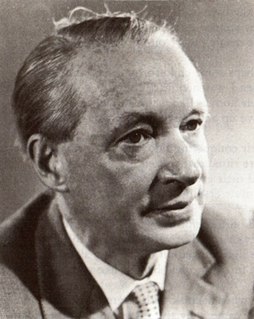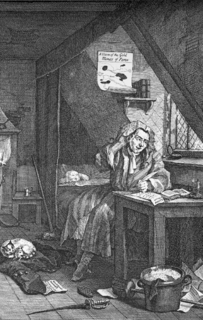
"A Description of a City Shower" is a 1710 poem by Anglo-Irish poet Jonathan Swift. First appearing in the Tatler magazine in October of that same year, the poem was considered his best poem. Swift agreed: "They think 'tis the best thing I ever wrote, and I think so too". [1] Bonamy Dobrée found it (and Swift's other Tatler verse, "A Description of the Morning") "emancipatory, defiantly anti-poetic... describing nothing that the common run of poets would seize on." [2]

Jonathan Swift was an Anglo-Irish satirist, essayist, political pamphleteer, poet and cleric who became Dean of St Patrick's Cathedral, Dublin.

"A Description of the Morning" is a poem by Anglo-Irish poet Jonathan Swift, written in 1709. The poem discusses contemporary topics, including the social state of London at the time of the writing, as well as the developing of commerce and business in the area, and the effect the latter had on the common people and common lifestyle in England. Others have also referred to the text as an early example of the oxymoronic "town eclogue," or "urban georgic". It was first published in October 1710, in the British magazine the Tatler, which was first printed in the same year of the poem's creation.
The text concerns modern, urban life, and the artificiality of that existence. The poem also parodies and imitates, in certain parts of its structure and diction, Virgil's Georgics . Other authorities suggest that the poem seeks to mock both the style and character of the way that then-contemporary city life was portrayed by other Augustan writers and poets. [3]
Artificiality is the state of being the product of intentional human manufacture, rather than occurring naturally through processes not involving or requiring human activity.
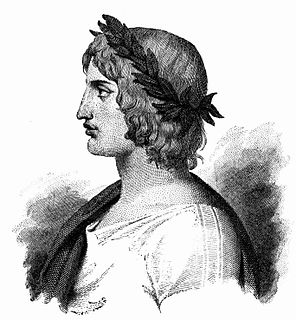
Publius Vergilius Maro, usually called Virgil or Vergil in English, was an ancient Roman poet of the Augustan period. He wrote three of the most famous poems in Latin literature: the Eclogues, the Georgics, and the epic Aeneid. A number of minor poems, collected in the Appendix Vergiliana, are sometimes attributed to him.

The Georgics is a poem by Latin poet Virgil, likely published in 29 BC. As the name suggests the subject of the poem is agriculture; but far from being an example of peaceful rural poetry, it is a work characterized by tensions in both theme and purpose.
"A Description of a City Shower" is cited as part of the inspiration for William Hogarth's Four Times of the Day , among other works. One of Hogarth's most famous works, Four Times of the Day sheds a humorous light on contemporary life in London, the mores of the various social classes of the city, and the mundane business of everyday life. Among the other works said to have provided Hogarth with inspiration for his series is the aforementioned "A Description of the Morning", published in the Tatler in 1709, as well as John Gay's "Trivia". [4]
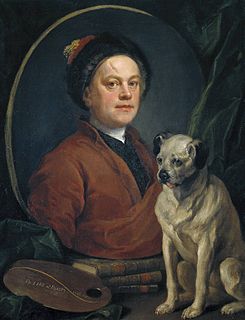
William Hogarth FRSA was an English painter, printmaker, pictorial satirist, social critic, and editorial cartoonist. His work ranged from realistic portraiture to comic strip-like series of pictures called "modern moral subjects", perhaps best known being his moral series A Harlot's Progress, A Rake's Progress and Marriage A-la-Mode. Knowledge of his work is so pervasive that satirical political illustrations in this style are often referred to as "Hogarthian".
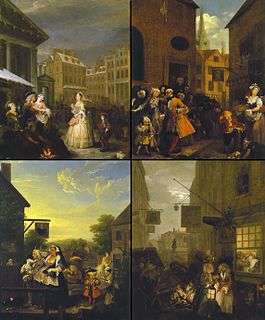
Four Times of the Day is a series of four oil paintings by English artist William Hogarth. Completed in 1736, they were reproduced as a series of four engravings published in 1738. They are humorous depictions of life in the streets of London, the vagaries of fashion, and the interactions between the rich and poor. Unlike many of Hogarth's other series, such as A Harlot's Progress, A Rake's Progress, Industry and Idleness, and The Four Stages of Cruelty, it does not depict the story of an individual, but instead focuses on the society of the city. Hogarth intended the series to be humorous rather than instructional; the pictures do not offer a judgment on whether the rich or poor are more deserving of the viewer's sympathies: while the upper and middle classes tend to provide the focus for each scene, there are fewer of the moral comparisons seen in some of his other works. Their dimensions are about 74 cm (29 in) by 61 cm (24 in) each.

John Gay was an English poet and dramatist and member of the Scriblerus Club. He is best remembered for The Beggar's Opera (1728), a ballad opera. The characters, including Captain Macheath and Polly Peachum, became household names.




